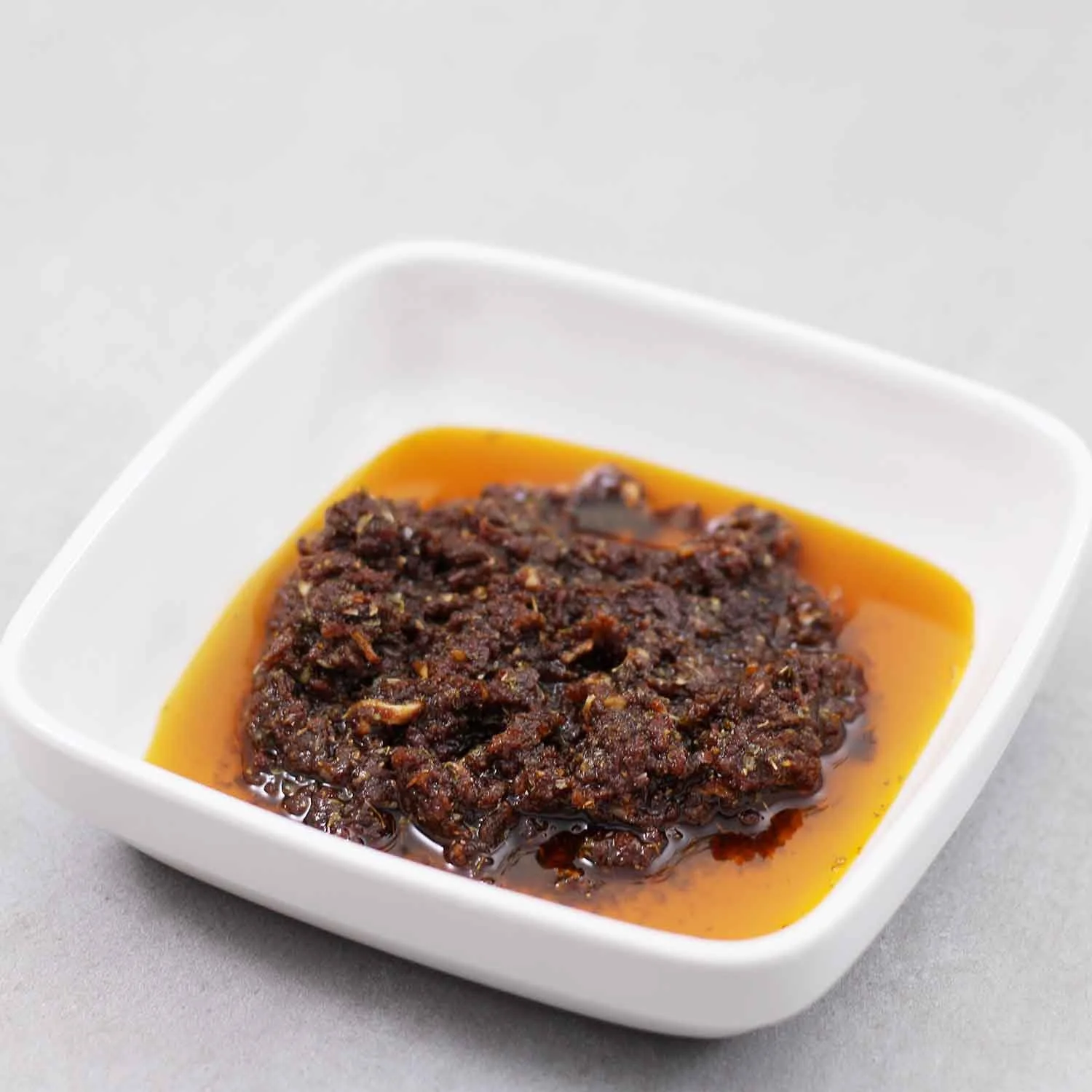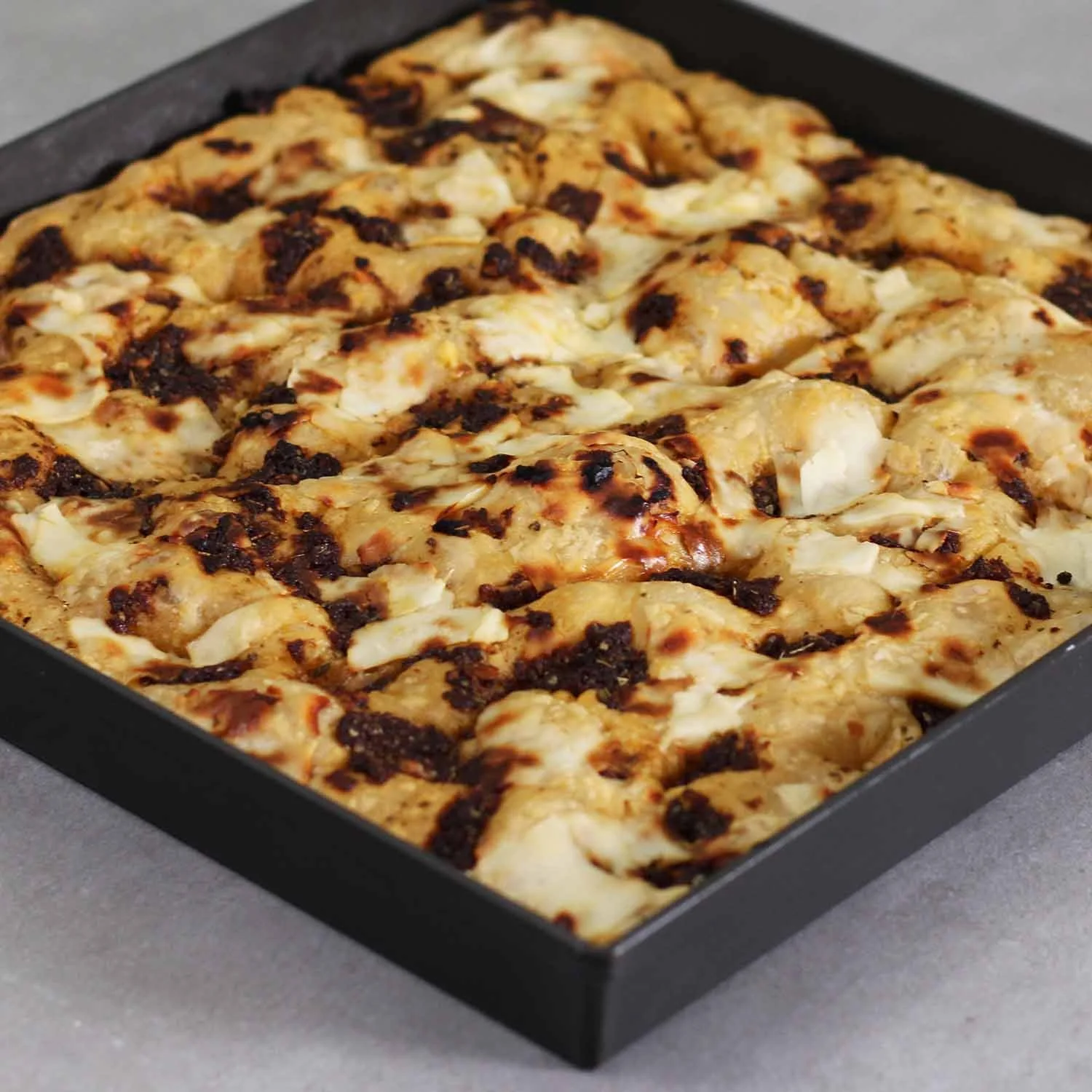Gourmet Focaccia with Pecorino Romano and Balsamic Toppings
This Gourmet Focaccia uses Pecorino Romano cheese and sweet balsamic vinegar. The result is an excellent flavor with the salty, tangy Pecorino balanced with balsamic sweetness.
Pecorino Romano cheese and balsamic vinegar make excellent toppings for a gourmet focaccia. This recipe is built upon a cold-fermented focaccia dough. The focaccia toppings are a savory herb, sweet balsamic vinegar mixture, or mélange, topped with shaved Pecorino. The result is the combination of salty, tangy Pecorino balanced with balsamic sweetness.
This focaccia recipe uses 80% hydration, so the water percentage is higher than in many Focaccia recipes. Exceeding 70% hydration is challenging. To make the dough, you need a stand mixer, preferably with a spiral hook.
Unique Gourmet Ingredients for Focaccia Toppings
Finding the right ingredient pairing for Focaccia toppings can create an incredible synergy of flavors. This occurs with salty, tangy Pecorino Romano and the sweetness of balsamic. The herb mélange, on its own, gives a savory background profile. The browned tomato paste and the anchovy sauce contribute to umami, enhancing the overall flavor. You can read more about flavor-enhancing ingredients on my umami sauce page.
Pecorino Romano Cheese
Pecorino Romano is a hard cheese made from Ewe’s milk (sheep’s milk). It is like Parmesan but is saltier, tangier, and more intense in flavor. Pecorino Romano cheese dates to at least 100 BC when it was written about as a food of the Roman legions. When aged, it is hard and crumbly. You can shave it with a vegetable peeler and then crumble it into flakes with your fingers, which I do when making the focaccia topping.
Gourmet Sweet Balsamic Vinegar
For this focaccia recipe, look for a dark, not white, gourmet balsamic. There are many balsamic options to choose from. Look for those with a decent level of sugar but no added sugars. The sugars in the balsamic should be purely from the ingredients (cooked grape must and vinegar) traditionally used for making balsamic vinegar. Avoid balsamic with “glaze” in the name, as these typically have added sugars. As the balsamic is paired with Pecorino Romano in this recipe, the natural caramelized grape sugars of the balsamic offset and complement the salty, tangy flavors of the Pecorino.
Colatura di alici - Anchovy Sauce
Colatura di alici is a fermented anchovy sauce with very historical Italian origins. Although expensive, it is worth the investment as it is an incredible gourmet cooking ingredient. You use it in minimal amounts; I only use 1/4 to 1/2 tsp in a typical recipe. It boosts flavor and melds into the background. It is very convenient; I use it instead of anchovies in recipes. This insightful video shows you how Colatura di alici is made.
The Focaccia Dough -Italian 00 flour - Double Zero Pizza and Bread Flour
The gourmet Focaccia toppings must sit on top of a dough made with strong flour. The Italian flour type 00 is a double-milled, powdery pizza and bread flour that absorbs water well and has a decent amount of gluten-forming ability. These characteristics make a bubbly focaccia dough that dimples well, resulting in a light, fluffy focaccia.
This gourmet focaccia is built on dough using a strong Caputo Chef's Flour. The Focaccia toppings are enhanced in sweetness with balsamic vinegar and a savory boost from Colatura di alici, anchovy sauce.
A Make Ahead Side Dish - Overnight Focaccia
I typically make this focaccia to go with a dinner the next day. The recipe lends itself well as a make-ahead side dish in the overnight focaccia bread category. The sequence I use is as follows:
On day one, the dough is made in a stand mixer, followed by a first rise in a proofing oven with the dough in a bowl. The dough is then shaped into the pan, followed by a second rise in the proofing oven. This is followed by a dimpling of dough in the typical manner used for focaccia. The balsamic herb mixture is made while the dough rises and then put on top of the dough. The final focaccia topping is shaved and flaked Pecorino Romano cheese. Then, it has an overnight cold rest and further dough fermentation in the refrigerator.
On day two, allow 30-45 minutes to warm at room temperature, followed by baking.
The Balsamic Herb Mélange
Focaccia toppings of Herbs with Balsamic vinegar
The predominant ingredient in the cooked topping mixture is dark balsamic vinegar. This sweetness balances the salty Pecorino Romano cheese also used to top the focaccia. Tomato paste and anchovy sauce build the savory flavor profile. The rosemary, oregano, and dried shallots also create flavor. These are sautéed in the classic extra virgin olive oil, which is typically placed on top of the focaccia.
Focaccia Topping Ingredients
1 tbsp tomato paste
1 tbsp dried rosemary
1 tbsp dried oregano
1/2 tsp garlic powder
2 cloves garlic or frozen cubes.
1/2 tsp anchovy sauce (Colatura di alici)
1 tbsp dried shallots
1/3 cup extra virgin olive oil
3 tbsp Balsamic vinegar
3 oz Pecorino Romano Cheese, shaved
The tomato paste is browned in olive oil for about two minutes at medium to high heat. Then, the heat is reduced to medium, and the crushed fresh garlic or frozen garlic cubes are sautéed. Dry herbs, anchovy oil, shallots, etc., are sautéed in the olive oil, tomato paste, and garlic mixture for about five minutes and refrigerated overnight. The Pecorino Ramon will be applied after the topping mixture when the dough is completed.
Instructions for Focaccia with Pecorino Romano Balsamic Topping
I use a 12 x 12 high-rimmed Detroit-style pizza pan. A 9 x 13 high-rimmed baking or cake pan has a similar surface area and height. Do not use a ceramic or glass baking dish; use a metal pan, as metal pans conduct heat better than ceramic baking dishes.
You grease the bowl and pan. I use vegetable shortening or non-stick cooking spray. It works very well either way. Always use a well-greased pan with high-hydration dough to ensure it does not stick.
Dough Ingredients
3-1/2 cups (450 grams) Caputo Chef's, a double-zero "00" flour
1-1/2 cups (360 grams) water
1 tbsp (14 grams) fresh yeast
1-1/2 tsp fine sea salt
1/4 tsp granulated sugar
1 tbsp olive oil
Add fresh, crumbled yeast and 1/4 tsp granulated sugar to the water. Let it sit for 7-10 minutes, preferably in a proofing oven. I like seeing the yeast active and well incorporated into the water.
Add the water and yeast mixture into your stand mixer bowl before any dry ingredients.
Add the dry ingredients, flour, and salt to your stand mixer bowl.
Run the mixer on low to medium-low for 3 minutes. If needed, periodically stop the mixer and scrape the bowl sides to incorporate the dry ingredients. Continue to run the mixer for 6 more minutes. At the end of 9 minutes, the dough should be clinging to your spiral hook.
Add the olive oil and run the mixer for 3 minutes on medium-high to high. The total time to prepare the dough in the mixer is 12 minutes.
Put the dough in a greased bowl. Using a clean dish towel, dampen it with warm water, and then cover the bowl.
Place the bowl with the dough in your proofing oven for 45-60 minutes,
Grease your cooking pan and then add an additional light coating of olive oil.
The dough should have doubled in size. Dump it directly into the baking pan. Spread the dough with your fingers to the corners of the pan, adding more olive oil at the edges and some on top so your fingers don't stick. If needed, add more olive oil to get the dough spread freely. If the dough resists spreading, let it sit for 5-10 minutes to relax the gluten and spread more. Repeat until the dough is evenly spread to the pan edges and corners.
Place the pan with the evenly distributed dough into your proofing oven again for 45-60 minutes.
Remove the pan and focaccia from the oven and dimple the dough with your fingers.
Apply the pre-cooked focaccia herb and balsamic toppings to the dough, gently spreading it with your fingers.
Let the dimpled focaccia with the herb balsamic toppings rest for about 15 minutes; during this time, the dough should bubble and rise some.
Using a vegetable peeler, shave the Pecorino Romano, then crumble it into smaller flakes with your fingers. Evenly distribute the flaked Pecorino over the focaccia.
Completely cover and tightly wrap the baking pan with cling wrap and refrigerate overnight and up to 24 hours before baking.
Bake in a 425° oven on the middle rack for 20-25 minutes. The time varies per oven, but I typically find the optimal time to be 23 minutes.
The Focaccia out of the oven.
Focaccia Making Best Practices
A few helpful tips for Focaccia recipes.
High protein flour
High hydration
Higher amounts of yeast than you would use for pizza
Use a high amount of olive oil.
Don't fret about kneading and folding the dough; it is not an artisan loaf of bread.
Favor salt for both the dough and toppings.
Pre-coat your pan lightly with shortening or a non-stick spray, followed by the olive oil. You don't want your high-hydration dough to stick to the pan.
Keep toppings as free of moisture and weight as possible.
You can pre-sauté your herb, garlic, and seasoning toppings in olive oil to drive out moisture and infuse them with the oil, which can prevent charring herbs and garlic and impart off flavors.




